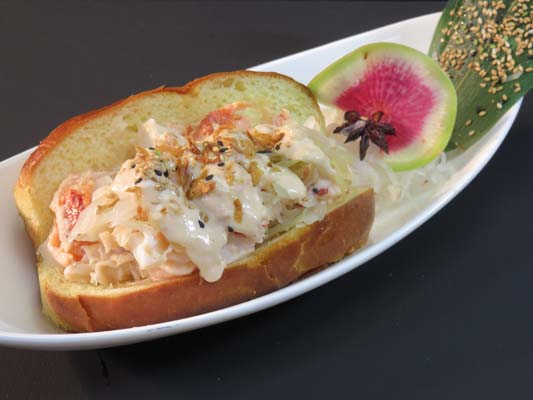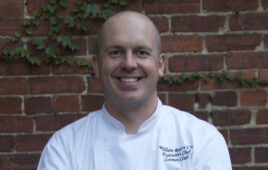Club chefs are on the lookout for the next exotic dish, technique or ingredient that is approachable, but still ignites curiosity.
The world is fast becoming a smaller place, and global ingredients like blue prawns and black mint, as well as dishes like paella and sushi, are no longer out of reach—or out of context—on club menus.

Hong Kong lobster roll made with fresh-picked lobster, house-made duck sauce, white soy, garlic mayo, and pickled cabbage by Edward Leonard, CMC, Director of Culinary Operations at The Polo Club of Boca Raton (Fla.).
Food as Food Should Be
For Edward Leonard, CMC, Director of Culinary Operations at The Polo Club of Boca Raton (Fla.), global cuisine—or “planetary cuisine,” as he calls it—has become as much a way of life as farm-to-table.
“Where ingredients are produced is much less important than how ingredients are produced,” says Leonard, who will be a featured presenter at C&RB’s 2017 Chef to Chef Conference in Atlanta next March. “Excellent ingredients come from all corners of the earth.”
Leonard’s “planetary” philosophy simply means sourcing excellent ingredients and serving them to The Polo Club’s members in simple, elegant ways.
“We respect the integrity of each product from the moment it comes through our doors until it reaches the plate,” says Leonard. One such example is The Polo Club’s paella, which is made with blue prawns from New Caledonia.
“It takes the producer nine months to grow a large, New Caledonian prawn, but the flavor is out of this world,” says Leonard, who contrasts the vibrant blue crustaceans to mainstream shrimp that are produced in three months. “It has a unique briny, sweet flavor that’s closer to lobster or langoustine.”
When Leonard used the blue shrimp in the paella, the members went wild.
“There are two things that make a great dish like this one,” says Leonard. “The product you buy, and what you do with it.”
Honoring Authenticity
Jason Hall, CMC, Executive Chef of Myers Park Country Club, Charlotte, N.C., follows a similar philosophy, where quality and authenticity trump trends and fads.
“I spent three years researching the development and production of a variety of global cuisines when I was preparing for the Master Chef exam,” says Hall. “It’s a huge part of the test. The more I learned, the more invested I became with accuracy.”
As a member of the 2016 Culinary Olympic team, Hall continues to explore global flavors both in the club’s kitchen and outside it. He’s especially interested in the spices of South America. He delivers these and other flavors to Myers Park’s 1,131 members in a number of ways—from a la carte menus to regional theme nights.
“Above all, global dishes need to be approachable,” says Hall.
Servers play an important role in helping with this outreach, as can the club’s newsletter, which Hall uses to lay the groundwork for member events like Myers Park’s annual open house in December.
“Each of the club’s five kitchens takes on a cuisine of the world and presents five or six dishes from that region,” says Hall in describing the open-house event. “The clubhouse becomes a melting pot of different cuisines.”
Beyond member events, global influences can be found on all of Myers Park’s menus, from a classic French consommé to a well-spiced Cajun étouffée.
“With so many different kitchens and outlets, we’re able to fuse global dishes into our menus throughout the club,” says Hall.
Global Meets Coastal
For Great Harbor Yacht Club (GHYC) on Nantucket in Massachusetts, seafood is a staple and access is easy, because the island is thirty miles off the coast.
Andre J. Marrero, GHYC’s Director of Culinary Operations and Executive Chef, finds clever ways to combine local seafood with global cuisine. For example, this past summer he paid tribute to the 2016 Olympics by featuring a dish called moqueca (Marrero presents the dish as “Brazilian seafood stew” on the club’s menu. “When you’re writing menus, try not to challenge the member by including words or terms they likely won’t know or recognize,” he advises.)
“Moqueca is a fish stew made with different kinds of seafood, coconut milk, tomatoes, onions, garlic and fresh cilantro,” says Marrero, who has been with GHYC since the end of 2014. “I was able to use local striped bass, fluke, cod, oysters and mussels, and infuse them with Brazilian flavors in this classic dish.”
It’s a perfect example of local meets global, as is another popular globally inspired dish at GHYC—the seared halibut, served over mashed potatoes and garlic spinach, and topped with an Asian glaze made with pickled mustard seeds, sake, mirin and white soy.
Chicken Worth Waiting For
Fieldstone Golf Club in Auburn Hills, Mich., menus global cuisine in a similar way. “On our a la carte menu we have dishes like Peruvian chicken that have become member favorites,” says Executive Chef Michael Barbas, who is especially interested in Asian, Spanish and Latin cuisines.
Fieldstone’s Peruvian chicken dish starts with a broken-down half-chicken that marinates for at least a day in a combination of garlic, chile, cilantro and black mint. It’s then roasted in the oven low-and-slow, and finished under high heat to get a nice crust. Barbas serves it atop rice and braised greens with red, yellow and green sauces.
“The biggest challenge with global cuisine used to be sourcing specialty ingredients like black mint,” says Barbas. “But that’s becoming less of an issue as it continues to evolve.”
His biggest challenge now is educating members. But, as for Hall at Myers Park, that comes down to educating the servers first.
“We’ll do tastings with the front-of-house staff on dishes that might be a little out of the ordinary,” says Barbas. “I want them to taste the flavors so they can speak from experience when they describe the dish to the member.”
He also uses global cuisine as a teaching tool for cooks and the kitchen staff. “It’s almost a recruiting tool for us,” he says. “When a potential hire sees the diversity of foods and cuisines that we offer, the world of club food becomes that much more attractive.”


